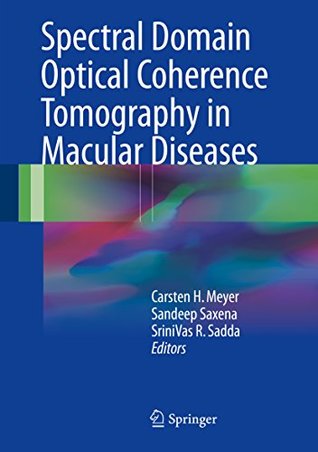Read Spectral Domain Optical Coherence Tomography in Macular Diseases - Carsten H Meyer | PDF
Related searches:
Optical coherence tomography� (oct), is a technique for obtaining sub-.
We present experimental results of a spectral-domain optical coherence tomography system based on an integrated optical spectrometer.
Spectral domain optical coherence tomography may aid in the management of glaucoma, the second leading cause of blindness in the world.
To investigate the profile and determinants of retinal optical intensity in normal subjects using 3d spectral domain optical coherence tomography (sd oct).
Optical coherence tomography (oct) allows for 3d imaging of living tissue. • oct can be modified to provide spectroscopic information (soct - spectroscopic oct). • spectral and time domain optical coherence spectroscopy is a new soct technique. • stdocs can be regarded as a bridge between oct and fourier transform spectroscopy.
This paper reviews the current state of research in spectral domain optical coherence tomography (sdoct).
Optical coherence tomography, (oct), is a technique for obtaining sub-surface images of translucent or opaque materials at a resolution equivalent to a low-power microscope. It is effectively ‘optical ultrasound’, imaging reflections from within tissue to provide cross-sectional images.
Optical coherence tomography (oct) is a technique used to image intraocular tissue structures.
13 aug 2008 following its original description by huang and workers in 1991, optical coherence tomography (oct) has steadily evolved into an integral.
Spectral domain optical coherence tomography (sd-oct) is the second generation of optical coherence tomography. In comparison to the first generation time domain optical coherence tomography (td- oct), sd-oct is superior in terms of its capturing speed, signal to noise ratio, and sensitivity.
Background and objective: to compare images of geographic atrophy (ga) obtained using spectral domain optical coherence tomography (sd-oct) with images obtained using fundus autofluorescence (faf). Patients and methods: five eyes from patients with dry amd were imaged using sd-oct and faf, and the size and shape of the ga were compared. Results: ga appears bright on sd-oct compared with the surrounding areas with an intact retinal pigment epithelium because of increased.
Keywords: spectral domain optical coherence tomography, spectral calibration, snr assessment.
Spectral domain optical coherence tomography (sd-oct) was proposed in the early 2000s.
4 dec 2020 pdf this paper reviews the current state of research in spectral domain optical coherence tomography (sdoct).
Spectrometer-based spectral domain optical coherence tomography (sdoct) system where the broadband laser source can be a superluminescent diode (sld) or a mode-locked ultra-fast laser source. Smf, single mode fiber; g, diffraction grating; pc, personal computer; ccd, charged-coupled device.
Abstract this paper reviews the current state of research in spectral domain optical coherence tomography (sdoct). Sdoct is an interferometric technique that provides depth-resolved tissue structure information encoded in the magnitude and delay of the back-scattered light by spectral analysis of the interference fringe pattern.
Purpose: spectral domain optical coherence tomography (sd-oct) allows cross-sectional visualization of retinal structures in vivo. Here, the authors report the efficacy of a commercially available sd-oct device to study mouse models of retinal degeneration. Methods: c57bl/6 and balb/c wild-type mice and three different mouse models of hereditary retinal degeneration (rho (-/-), rd1, rpe65 (-/-)) were investigated using confocal scanning laser ophthalmoscopy (cslo) for en face visualization.
30 may 2018 this paper reviews the current state of research in spectral domain optical coherence tomography (sdoct).
15 jun 2020 individual macular layer evaluation with spectral domain optical coherence tomography in normal and glaucomatous eyes.
Optical coherence tomography (oct) is a non-invasive diagnostic technique that renders an in vivo cross sectional view of the retina. Oct utilizes a concept known as inferometry to create a cross-sectional map of the retina that is accurate to within at least 10-15 microns. Oct was first introduced in 1991 and has found many uses outside of ophthalmology, where it has been used to image certain non-transparent tissues.
In choroidal tumors, traditional time-domain and spectral-domain optical coherence tomography (sd-oct) are most useful for visualizing secondary changes to the retina and retinal pigment epithelium (rpe). 21 in choroidal hemangiomas, oct can be used to demonstrate macular edema, epiretinal membranes, and subretinal fluid (fig.
Spectral domain optical coherence tomography (sd-oct) as one kind of oct has become a very important biological imaging modality, especially in ophthalmology, because of its advantages of high resolution, fast imaging speed, and high signal-to-noise ratio (snr) [1,2,3]. Imaging speed and imaging depth are two significant performance indications.
A recent advance in oct technology, spectral-domain oct (sd-oct), has significantly increased scanning speeds (more than 100 fold in some cases) and has been touted as a dramatic advance in retinal imaging.
Optical coherence tomography (oct), first described in 1991, is a noncontact, noninvasive imaging technique that can reveal layers of the retina by looking at the interference patterns of reflected laser light.
It is the current gold standard for posterior segment retinal tomography. Since 2004, higher-resolution spectral-domain oct (sd oct) has entered clinical practice.
Tomography (sd-oct) is the second generation of optical coherence tomography.
Optical coherence tomography (oct) is a rapidly evolving, robust technology that has profoundly changed the practice of ophthalmology.


Post Your Comments: